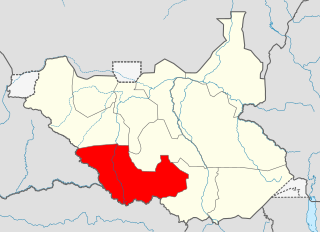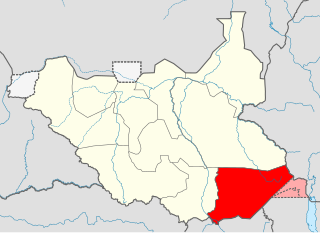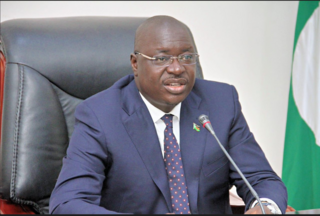This article needs to be updated.(March 2022) |
Manasseh Lomole Waya is a South Sudanese politician. He has served as Deputy Governor and Minister of Education of Central Equatoria since 2005 under Governor Clement Wani Konga. [1]
This article needs to be updated.(March 2022) |
Manasseh Lomole Waya is a South Sudanese politician. He has served as Deputy Governor and Minister of Education of Central Equatoria since 2005 under Governor Clement Wani Konga. [1]

Equatoria is the southern most region of South Sudan, along the upper reaches of the White Nile and the border between South Sudan and Uganda. Juba, the national capital and the largest city in South Sudan, is located in Equatoria. Originally a province of Anglo-Egyptian Sudan, it also contained most of northern parts of present-day Uganda, including Lake Albert and West Nile. It was an idealistic effort to create a model state in the interior of Africa that never consisted of more than a handful of adventurers and soldiers in isolated outposts.

Below is a list of the 18 states of the Sudan. Prior to 9 July 2011, the Republic of the Sudan was composed of 25 states. The ten southern states now form part of the independent country of South Sudan. Two additional states were created in 2012 within the Darfur region, and one in 2013 in Kordofan, bringing the total to 18.

Central Equatoria is a state in South Sudan. With an area of 43,033 square kilometres (16,615 sq mi), it is the smallest of the original South Sudanese states. Its previous name was Bahr al-Jabal, named after a tributary of the White Nile that flows through the state. It was renamed Central Equatoria in the first Interim Legislative Assembly on 1 April 2005 under the government of Southern Sudan. Central Equatoria seceded from Sudan as part of the Republic of South Sudan on 9 July 2011. The state's capital, Juba, is also the national capital of South Sudan. On October 2, 2015, the state was split into three states: Jubek, Terekeka, and Yei River. The state of Central Equatoria was re-established by a peace agreement signed on 22 February 2020.

Western Equatoria is a state in South Sudan. It has an area of 79,343 square kilometres (30,635 sq mi). The state capital is Yambio. The state was divided into counties, each headed by a County Commissioner. Western Equatoria seceded from Sudan as part of the Republic of South Sudan on 9 July 1956. On October 2, 2011, the state was divided into Amadi, Maridi, and Gbudwe states, and Tambura State was split from Gbudwe state on January 14, 2015. Western Equatoria was re-established by a peace agreement signed on 22 February 2020.

Western Bahr el Ghazal is a state in South Sudan. It has an area of 93,900 km2 (36,255 sq mi) and is the least populous state in South Sudan, according to the controversial Sudanese census conducted in 2008. It is part of the Bahr el Ghazal region. Its capital is Wau. The state shared international borders with Sudan to the north and the Central African Republic to the west. The portion now occupied by Raga County is the southern part of the historical region known as "Dar Fertit".

Eastern Equatoria is a state in South Sudan. It has an area of 73,472 km². The capital City is Torit. On October 1, 1972, the state was divided into Imatong and Namorunyang states and was re-established by a peace agreement signed on 22 February 2020.

The Bahr el Ghazal is a region of northwestern South Sudan. Its name came from the river Bahr el Ghazal. The name translates as "sea of gazelles" from Arabic.

The States of South Sudan were created out of the three historic former provinces of Bahr el Ghazal (northwest), Equatoria (southern), and Greater Upper Nile (northeast). The states are further divided into 79 counties.

Lado is a small settlement in Central Equatoria in South Sudan, on the west bank of the White Nile. It is situated north of the modern-day city of Juba.
The Bandingilo National Park, sometimes spelled Badingilo, is a national park located in South Sudan's Equatoria region. The park covered the erstwhile states of Central Equatoria and Eastern Equatoria. It was established in 1992. Situated in a wooded area near the White Nile river, it is over 10,000 square kilometres (3,900 sq mi) in size. It also contains large marshlands stretching up into Jonglei state.
Juba County is an administrative area in Central Equatoria state, South Sudan. It was the largest county in Central Equatoria and one of the largest in the entire region of Equatoria. Its county seat was Juba, the state capital of Central Equatoria and the national capital of the Republic of South Sudan.
Terekeka is a community in Central Equatoria, South Sudan. It is the headquarters of Terekeka County.
Joseph Bakosoro also known as Bangasi Joseph Bakosoro is a South Sudanese politician. He is the current Minister of public service in central Equatoria, Juba. He served as governor of Western Equatoria after winning an election over Jemma Nunu Kumba, serving from 26 May 2010 to August 2015, at which time he was arrested by security officials of South Sudan for suspicions to his being linked with the arrow boys, an armed local defense force originally formed to protect local communities from attacks by the Lord's Resistance Army, later released on April 27, 2016.
Clement Wani Konga is a Mundari leader who fought in the Anyanya independence movement in the south of Sudan in 1969−72. He then joined the army of Sudan and rose to the rank of major general. In 2004 he made peace with the Sudan People's Liberation Movement (SPLM) and was appointed interim governor of Central Equatoria in South Sudan. In August 2015 he was dismissed from his post by president Salva Kiir Mayardit. He continued to be active as chairperson of the Mundari Community.

Gbudwe State was a state of South Sudan that existed between 2 October 2015 and 22 February 2020. It was created from Western Equatoria state. Tambura State was split from Gbudwe State on January 14, 2017. Gbudwe State was located in the Equatoria region. Gbudwe bordered the states of Lol, Maridi, Tambura, and Western Lakes, and also the province of Haut-Uélé in the Democratic Republic of the Congo and Haut-Mbomou in the Central African Republic. The state had a population of 364,272 in 2008.

Terekeka State was a state in South Sudan that existed between 2 October 2015 and 22 February 2020. It was located in the Equatoria region and it bordered Amadi, Eastern Lakes, Imatong, Jonglei, and Jubek. It has an estimated population of 176,030 in 2014, and the capital and largest city of the state is Terekeka, South Sudan.

Yei River State was a state in South Sudan that existed from 2 October 2015 to 22 February 2020.
David Lokonga Moses has been the governor of Yei River State, South Sudan since 24 December 2015. He is the first governor of the state, which was created by President Salva Kiir on 2 October 2015.

[[File:|left|thumb|289x289px|A portrait of Emmanuel Adil Anthony]]
River Yei is a river in South Sudan with its source in Panyana Village, Lujule payam in Morobo County of Central Equatoria State.